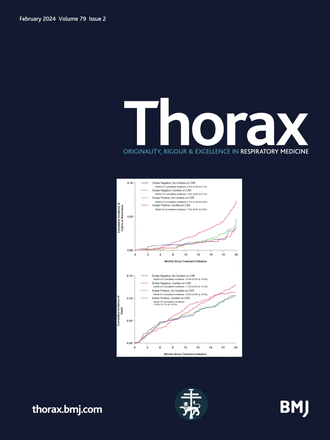Lung adenocarcinoma with multiple cavitary lung lesions
IF 9
1区 医学
Q1 RESPIRATORY SYSTEM
引用次数: 0
Abstract
A 68-year-old Asian woman was referred to our department because of an abnormal chest X-ray showing multiple patchy consolidative nodules and cavitary lesions, suggestive of a wide range of differential diagnoses, including infection, metastatic tumour, connective tissue disease and vasculitis. The patient had no relevant medical, medication or smoking histories. Chest CT revealed multiple diffuse, thick-walled, cavitary lung lesions with nodules and surrounding consolidation in both lung fields (figure 1, upper row). The laboratory findings revealed white blood cell, 8000/µL (Neu, 69.2%; Lym, 22.2%; Mono, 7.0%); C-reactive protein, 3.59 mg/dL; lactate dehydrogenase, 177 U/L; Beta-D-Glucan, <5 pg/mL; Aspergillus antigen, (−); perinuclear/cytoplasmic antineutrophil cytoplasmic antibody, (−); and interferon-gamma release assay for tuberculosis, (−). The only tumour marker significantly elevated was carbohydrate antigen 19–9 (CA19-9; 1072.7 U/mL; reference range: 0–37 U/mL). The bilateral cavitary lesions and laboratory findings suggested metastasis of an intra-abdominal cancer such as pancreatic cancer. However, contrast-enhanced abdominopelvic CT and whole-body positron emission tomography (PET-CT) revealed no evidence of abdominal, retroperitoneal or gynaecological tumours (figure 1, right). Transbronchial lung biopsy from right segment 6, the largest, most accessible lesion with intense uptake on PET-CT, revealed a lung adenocarcinoma (Napsin A positive; thyroid transcription factor 1 negative) with …肺腺癌伴多腔肺病变
一名68岁亚洲女性因胸部x线异常显示多发斑片状实变结节和空洞性病变,提示多种鉴别诊断,包括感染、转移性肿瘤、结缔组织疾病和血管炎而转介至我科。患者无相关医疗、用药或吸烟史。胸部CT示双肺野多发弥漫性、厚壁、空洞性病变,伴结节及周围实变(图1,上排)。实验室结果:白细胞,8000/µL (Neu, 69.2%;Lym, 22.2%;Mono, 7.0%);c反应蛋白,3.59 mg/dL;乳酸脱氢酶,177 U/L;β - d -葡聚糖,<5 pg/mL;曲霉抗原(−);核周/细胞质抗中性粒细胞细胞质抗体,(−);结核病干扰素释放试验,(−)。唯一显著升高的肿瘤标志物是碳水化合物抗原19-9 (CA19-9;1072.7 U /毫升;参考范围:0-37 U/mL)。双侧腔病变和实验室检查提示腹腔内肿瘤如胰腺癌转移。然而,对比增强的骨盆CT和全身正电子发射断层扫描(PET-CT)未显示腹部、腹膜后或妇科肿瘤的证据(图1,右)。右肺第6段经支气管活检显示肺腺癌(Napsin a阳性;甲状腺转录因子1阴性)。
本文章由计算机程序翻译,如有差异,请以英文原文为准。
求助全文
约1分钟内获得全文
求助全文
来源期刊

Thorax
医学-呼吸系统
CiteScore
16.10
自引率
2.00%
发文量
197
审稿时长
1 months
期刊介绍:
Thorax stands as one of the premier respiratory medicine journals globally, featuring clinical and experimental research articles spanning respiratory medicine, pediatrics, immunology, pharmacology, pathology, and surgery. The journal's mission is to publish noteworthy advancements in scientific understanding that are poised to influence clinical practice significantly. This encompasses articles delving into basic and translational mechanisms applicable to clinical material, covering areas such as cell and molecular biology, genetics, epidemiology, and immunology.
 求助内容:
求助内容: 应助结果提醒方式:
应助结果提醒方式:


